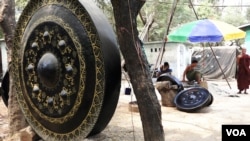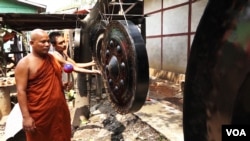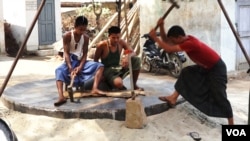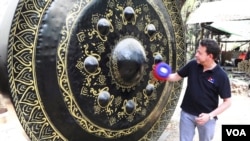Under the tamarind trees on the grounds of the Zay Ya Mingalar monastery, the bronze age is finally giving way to the iron age.
This is strikingly evident when a resident Buddhist monk slams a mallet into the center of a 2.5-diameter meter bossed gong, emanating a rumble that echoes across the courtyard.
The giant instrument is testament to a technological breakthrough, as it is composed of iron ore.
Traditionally gongs, ubiquitous in temples in the Ayeyarwady Region to the south, have been made of bronze.
The primary component bronze is copper, which saw a price increase of about 500 percent over the first decade of this century. Copper hit a six-year low in January, but the cost has increased nearly 20 percent again since then.
The market instability prompted gong makers in neighboring Thailand to switch from bronze to iron and their product began cutting into domestic sales in Myanmar. The Thai gongs are not only far cheaper than bronze models, they can also be made quickly – in about a month compared to a year for comparably large iron gongs.
But the large Thai iron gongs cannot produce a tuned note, thus they are merely decorations and not instruments.
And sound and size do matter.
“People want bigger gongs with good sound so that’s why we began casting iron metal giant gongs,” craftsman Than Zaw explains, noting their innovation has allowed them to fight back against what is regarded here as an inferior imported product.
Most buyers of large gongs in Myanmar are worshippers, not the temples themselves. Patrons then donate the gongs to their local temples and monasteries to earn spiritual merit.
“They like to donate big gongs which are capable of producing a pleasant sound,” Than Zaw told VOA.
While Buddhist monks are traditionally ascetic, their followers, especially the well-to-do in this developing country, can tend towards the ostentatious.
Donating a huge gong not only is meritorious, it earns bragging rights among one’s peers, the local craftsmen note.
“The sound of the gong also represents luck and success for Myanmar’s people. That’s why donors usually hit a gong after making donations at a temple,” said monk Panna Jota, who traveled 600 kilometers from Mon state to purchase a modest-sized gong at the Mandalay workshop.
The largest Myanmar iron gong yet is now in production at the open-air commercial enterprise on the monastery grounds. It is 2.75 meters in diameter and weighs 245 kilograms. It is to be sold for $2,900.
Two workers are hammering imperfections into its surface so that it will resonate with prospective purchasers.
“A press machine would make it look smoother but it would produce a metallic sound like hitting an iron or bronze plate. Machinery cannot produce the correct gong pitch and beat,” said Zin Min, a casting specialist on site. “Thus we need to hit it with hammers to get a rough surface like this.”
The masters are hoping to cast a gong as large as five meters in diameter, but that will require a commissioned order costing $6,200, plus food and accommodations for seven or eight workers in Mandalay during the three months it would take to make the instrument.
For the monk from Mon, the gongs are an integral part of Myanmar’s cultural identity and yet another reason to buy domestic.
“From long ago our warriors going into battle would become energized by the sound of the gong and fight to win,” Pann Jota explained. “For us it’s the sound of success and victory.”
















